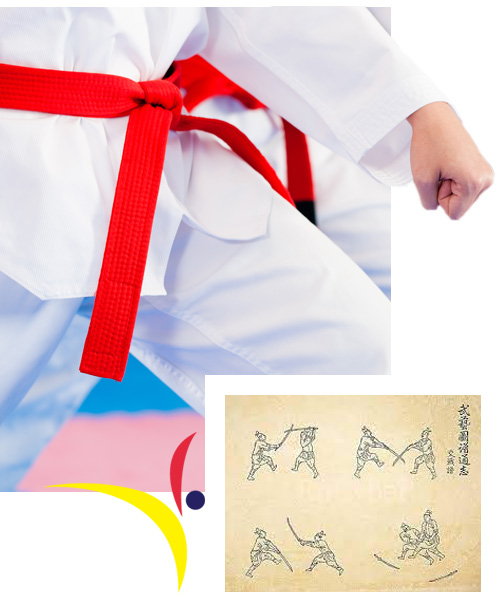
2,333 BC
Gojoseon, the first country on the Korean Peninsula
Kingdoms Period, when the wars of conquest were active.
Goguryeo developed techniques for handling weapons such as archery, swords, and spears, and Baekje honed various bare-handed martial arts as can be seen in the figures of Baekje Geumdong Hyang-ro. In Silla, various bare-handed martial arts such as watermelon, horseback riding, Deokgyeon, Geggeum, and ssireum were prevalent.

bare-handed martial arts during the Three Kingdoms Period

- Goguryeo (37 B.C. ~ 668 A.D)
- Goguryeo was a country with a high spirit of commerce. At that time, soldiers such as youth and Jo's ancestors, who were educated in Gyeongdang, a national educational institution, honed their skills in handling weapons such as swords and spears as well as archery, and practiced bare-handed martial arts such as ssireum and watermelon. The two warriors' competing posture in dance guns and other murals is certainly similar to today's taekwondo competition, which proves that bare-handed competition existed in Goguryeo's time.
- Baekje (18B.C to 660A.D)
- Baekje's bare-handed martial art can be found in the figure of Geumdong Daehyang-ro, Baekje, excavated in 1993. The figure is confirmed at the top of the lotus leaf of the body of the incense burner, and the left arm is stretched and the legs are bent, making a dynamic movement that feels strength and tension. The Baekje people, like the Goguryeo people, practiced various martial arts, and it can be assumed that there must have been bare-handed martial arts similar to today's Taekwondo.
- Silla (57B.C to 936A.D)
- In Silla, there were various types of bare-handed martial arts. This fact can be supported by the Musayong excavated from the Yonggang Dong Ancient Tombs in Gyeongju, which are believed to have been manufactured from the late 7th to early 8th centuries. The three Musayong can be seen as the bodyguards of the accused, who are presumed to be true bones and status, and all three have different competing postures, so you can guess the bare-handed martial arts practiced at that time.
The soldiers in Yonggang-dong are taking the form of their hands, and now they are taking the form of outer blocking in martial arts such as Taekwondo. It is presumed that this was a careful expression of the unit movement of bare-handed martial arts at that time.
bare-handed martial arts during the Joseon Dynasty

- bare-handed martial arts during the Joseon Dynasty (1392A.D to 1945A.D)
-
It was a representative bare-handed martial art watermelon from the early Joseon Dynasty. Watermelon continued to exist even after the collapse of Goryeo and the establishment of the Joseon Dynasty. In the Annals of the Joseon Dynasty, watermelon is marked as watermelon (手搏), watermelonhee (手搏戱), and watermelon (手拍), and appeared 17 times from 1410 (10th year of King Taejong's reign) to 1467 (13th year of King Sejo's reign).
Kwonbeop, a bare-handed martial artist whose details appear in Kwonbo, Muyebojeo Translation Synopsis, Muyeshinbo, and Muyedobo Notification published in the middle of the Joseon Dynasty, was an essential basic martial art required to learn danbyeong such as Nangseon, Jangchang, partisans, and dungpae, which were very effective in fighting the Japanese army, and for this reason, the Joseon court actively promoted the dissemination of Kwonbeop as a military martial art.
During the Imjin War, the Joseon court made them practice the martial arts learned from the soldiers of the Ming Dynasty instead of watermelonhee, which was widely practiced in the early Joseon period as a basic training for martial arts training. However, if you look at the martial arts notice's martial arts, there are techniques to overpower each other as if two people wrestled, called Gapeulbu (甲乙相負), so you can guess that the martial arts learned from the Ming army were further developed by combining them with our own martial arts.
In the property report compiled by Lee Man-young in 1798, the names of bare-handed martial arts such as Shubak, Takttak, and Ssireum appeared, indicating that various bare-handed martial arts were practiced in the private sector. It can also be seen from Yoo Sook's (Daepyeongdo) that various martial arts were practiced in the private sector. (Daepyeongdo) depicts the figures facing with their arms wide open, and the figures who compete for power by holding their waist dances, and it is presumed to be a common practice in that many people are watching.
Development of Taekwondo After Independence
During the enlightenment period, there was an influx of foreign martial arts from China and Japan, and during the Japanese colonial period, due to the regulations and oppression of the Japanese Government-General, our own martial arts training such as Taekkyeon and watermelon was strictly restricted. For this reason, Chinese martial arts and Japanese martial arts were trained in combination with Korean martial arts, and the transformation of Korean martial arts was faced.
Finally, on September 14, 1961, the Taekwondo Integration Foundation Committee was organized, and on June 25, 1962, the Korea Taekwondo Association joined the Korean Sports Association and was recognized as an official organization representing the Taekwondo world. The following year, in October 1963, it became an official event of the 4th National Sports Festival for the first time, providing an opportunity for Taekwondo to become an official sports organization, and on August 5, 1965, the Korea Taekwondo Association was finally changed to the name of the "Korea Taekwondo Association".
Taekwondo of the present time

-
In order to develop Taekwondo globally, the integration of the Taekwondo world was the top priority, and each coffin of Taekwondo needed a symbolic seal that could be combined into one. Therefore, on November 30, 1972, "Kukwongi" was established as the central stamp of the Korean Taekwondo Association and plays a pivotal role in maintaining the Taekwondo tradition and distributing Taekwondo to the movement of people around the world.
The Taekwondo department began to be opened in the university in 1980, and now more than 50 universities have opened Taekwondo-related departments (majors) to form a foundation for the development of Taekwondo, and are exploring the new status of Taekwondo in the 21st century human society, where knowledge and information are based. Universities in many countries, including the United States, Canada, Australia, Uzbekistan, and China, have already opened Taekwondo as a major or have adopted it as an official subject to promote the development of Taekwondo.
The 1988 Seoul Olympics laid the foundation for the globalization of Taekwondo as it participated as a demonstration event, and at the 103rd General Assembly of the International Olympic Committee (IOC) held in Paris, France on September 4, 1994, Korean national flag Taekwondo became the official term for the Olympic Games along with English, French, and Japanese as it was adopted as an official event for the 2000 Sydney Olympics, 2004 Athens Olympics, 2008 Beijing Olympics, 2012 London Olympics, and 2016 Brazil Olympics.
Currently, Taekwondo has established itself as a martial arts sport for people around the world trained by 80 million Taekwondo people in 201 countries as an exercise to cultivate the right personality and develop healthy physical abilities.

